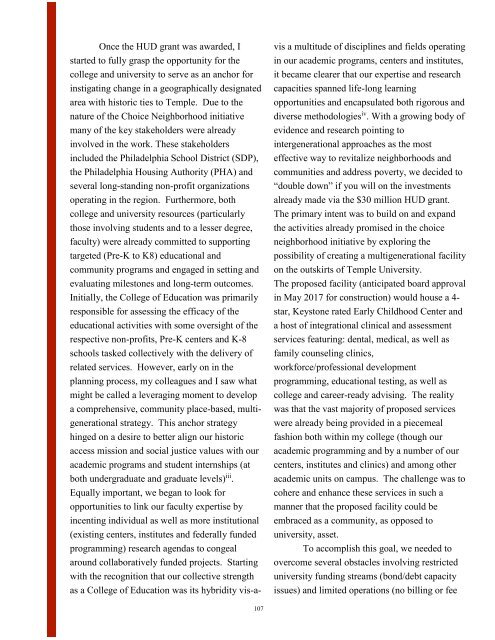CLC-Conference-Proceeding-2018
Create successful ePaper yourself
Turn your PDF publications into a flip-book with our unique Google optimized e-Paper software.
Once the HUD grant was awarded, I<br />
started to fully grasp the opportunity for the<br />
college and university to serve as an anchor for<br />
instigating change in a geographically designated<br />
area with historic ties to Temple. Due to the<br />
nature of the Choice Neighborhood initiative<br />
many of the key stakeholders were already<br />
involved in the work. These stakeholders<br />
included the Philadelphia School District (SDP),<br />
the Philadelphia Housing Authority (PHA) and<br />
several long-standing non-profit organizations<br />
operating in the region. Furthermore, both<br />
college and university resources (particularly<br />
those involving students and to a lesser degree,<br />
faculty) were already committed to supporting<br />
targeted (Pre-K to K8) educational and<br />
community programs and engaged in setting and<br />
evaluating milestones and long-term outcomes.<br />
Initially, the College of Education was primarily<br />
responsible for assessing the efficacy of the<br />
educational activities with some oversight of the<br />
respective non-profits, Pre-K centers and K-8<br />
schools tasked collectively with the delivery of<br />
related services. However, early on in the<br />
planning process, my colleagues and I saw what<br />
might be called a leveraging moment to develop<br />
a comprehensive, community place-based, multigenerational<br />
strategy. This anchor strategy<br />
hinged on a desire to better align our historic<br />
access mission and social justice values with our<br />
academic programs and student internships (at<br />
both undergraduate and graduate levels) iii .<br />
Equally important, we began to look for<br />
opportunities to link our faculty expertise by<br />
incenting individual as well as more institutional<br />
(existing centers, institutes and federally funded<br />
programming) research agendas to congeal<br />
around collaboratively funded projects. Starting<br />
with the recognition that our collective strength<br />
as a College of Education was its hybridity vis-avis<br />
a multitude of disciplines and fields operating<br />
in our academic programs, centers and institutes,<br />
it became clearer that our expertise and research<br />
capacities spanned life-long learning<br />
opportunities and encapsulated both rigorous and<br />
diverse methodologies iv . With a growing body of<br />
evidence and research pointing to<br />
intergenerational approaches as the most<br />
effective way to revitalize neighborhoods and<br />
communities and address poverty, we decided to<br />
“double down” if you will on the investments<br />
already made via the $30 million HUD grant.<br />
The primary intent was to build on and expand<br />
the activities already promised in the choice<br />
neighborhood initiative by exploring the<br />
possibility of creating a multigenerational facility<br />
on the outskirts of Temple University.<br />
The proposed facility (anticipated board approval<br />
in May 2017 for construction) would house a 4-<br />
star, Keystone rated Early Childhood Center and<br />
a host of integrational clinical and assessment<br />
services featuring: dental, medical, as well as<br />
family counseling clinics,<br />
workforce/professional development<br />
programming, educational testing, as well as<br />
college and career-ready advising. The reality<br />
was that the vast majority of proposed services<br />
were already being provided in a piecemeal<br />
fashion both within my college (though our<br />
academic programming and by a number of our<br />
centers, institutes and clinics) and among other<br />
academic units on campus. The challenge was to<br />
cohere and enhance these services in such a<br />
manner that the proposed facility could be<br />
embraced as a community, as opposed to<br />
university, asset.<br />
To accomplish this goal, we needed to<br />
overcome several obstacles involving restricted<br />
university funding streams (bond/debt capacity<br />
issues) and limited operations (no billing or fee



